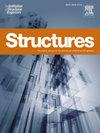用于估算 CLT 面板弯曲刚度的伽马法修正建议
IF 3.9
2区 工程技术
Q1 ENGINEERING, CIVIL
引用次数: 0
摘要
交叉层压木材(CLT)等工程木制品已广泛应用于民用建筑。标准计算方法,如结构设计中常用的伽马法,可以估算出构件的弯曲刚度。然而,这些方法都是基于一维实体(条形构件),可能会有局限性。这种限制可能会导致估算不准确,尤其是当面板的尺寸(在中轴平面上测量)相差一个数量级时。在这项研究中,使用有限元法(三维方法)进行了参数研究,改变了板材的尺寸(宽度和长度)、层厚度和层数(横截面高度),并采用了考虑木材正交性或滚动剪切估算的弹性特性(共进行了 108 次数值模拟)。在参数化的基础上,使用多变量回归模型建立修正系数,并将其纳入伽马法,以提高其估算弯曲刚度的准确性。因此,与伽马法(MAPE = 2.13 %,RMSE = 7.47 × 10 Nmm,CV = 4.04 %)相比,单一调整方程(考虑木材的正交性)显示的值更接近数值值(MAPE = 0.95 %,RMSE = 2.96 × 10 Nmm,CV = 1.60 %)。本文章由计算机程序翻译,如有差异,请以英文原文为准。
Proposed correction to the Gamma method for estimating the bending stiffness of CLT panels
Engineered wood products, such as Cross Laminated Timber (CLT), have been widely used in civil construction. Standard calculation methods, like the Gamma method commonly used in structural design, estimate the bending stiffness of elements. However, these methods are based on one-dimensional solids (bar elements), which can be limiting. This limitation may result in inaccurate estimates, especially when the panel's dimensions, measured in the median plane, significantly differ by an order of magnitude. In this research, a parametric study was carried out using the finite element method (three-dimensional approach), varying the panel's dimensions (width and length), the layers' thickness, and the number of layers (cross-section height), and adopting elastic properties considering either the wood's orthotropy or the rolling shear estimation (108 numerical simulations in all). Based on the parameterization, multiple variable regression models were used to establish a correction coefficient to be incorporated into the Gamma method to improve its accuracy in estimating bending stiffness. Therefore, the single adjusted equation (considering the wood's orthotropy) showed values closer to the numerical ones (MAPE = 0.95 %, RMSE = 2.96 × 10 Nmm, and CV = 1.60 %) than those obtained by the Gamma method (MAPE = 2.13 %, RMSE = 7.47 × 10 Nmm, and CV = 4.04 %).
求助全文
通过发布文献求助,成功后即可免费获取论文全文。
去求助
来源期刊

Structures
Engineering-Architecture
CiteScore
5.70
自引率
17.10%
发文量
1187
期刊介绍:
Structures aims to publish internationally-leading research across the full breadth of structural engineering. Papers for Structures are particularly welcome in which high-quality research will benefit from wide readership of academics and practitioners such that not only high citation rates but also tangible industrial-related pathways to impact are achieved.
 求助内容:
求助内容: 应助结果提醒方式:
应助结果提醒方式:


